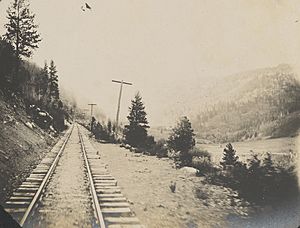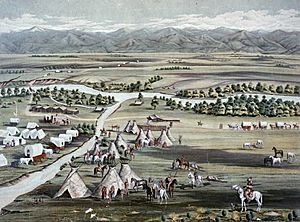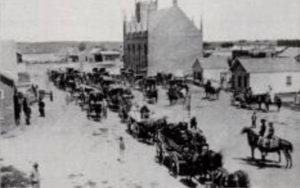John Evans (Colorado governor) facts for kids
Quick facts for kids
John Evans
|
|
|---|---|
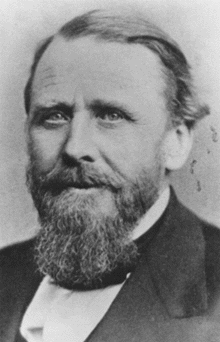 |
|
| 2nd Governor of the Territory of Colorado | |
| In office March 26, 1862 – October 17, 1865 |
|
| Preceded by | William Gilpin |
| Succeeded by | Alexander Cummings |
| Personal details | |
| Born | March 9, 1814 near Waynesville, Ohio |
| Died | July 2, 1897 (aged 83) Denver, Colorado |
| Political party | Whig, then Republican (1850s +) |
| Spouses | Hannah Canby Margaret Gray Evans |
| Children | Josephine Evans Elbert William Gray Evans Anne Evans |
| Signature | |
John Evans (born March 9, 1814 – died July 2, 1897) was an important American figure in the 1800s. He was a doctor, a politician, and a businessman. He helped start many hospitals and medical groups. He also helped build railroads, which made cities grow. He was the governor of the Colorado Territory and helped found two major universities: Northwestern University and the University of Denver. Places like Evanston, Illinois, Evans, Colorado, and Mount Evans in Colorado are named after him.
John Evans is especially remembered for helping to create Northwestern University and the University of Denver. The highest honors for professors at these universities are called "John Evans professorships." He also helped Denver grow from a small settlement into a big city by bringing railroad lines there.
However, Evans was also forced to resign as governor in 1865. This happened because of his part in the Sand Creek massacre. This event was one of the worst attacks on Native Americans in U.S. history.
Early Life and Education
John Evans was born on March 9, 1814, in Waynesville, Ohio. His parents were Rachel and David Evans. His father was a farmer, owned a hardware store, and invested in land.
John began studying medicine at Clermont Academy in Philadelphia. He earned his medical degree from Cincinnati College in March 1838.
John Evans's Career and Contributions
Medicine and Healthcare

In December 1838, Evans moved to West Milton, Ohio, after marrying Hannah Canby. In July 1839, they moved to Attica, Indiana. There, he started a medical practice. He also decided to build a hospital for people with mental illness.
The Evans family moved to Indianapolis in 1843. This helped him work with the Indiana government to get his hospital idea approved. On January 15, 1844, a law was passed to create a state hospital. Evans was chosen to help build it. He learned that fresh food, water, and a country setting were important for patient care. In 1846, he oversaw the building of the Indiana Central State Hospital. He became its first leader in 1845.
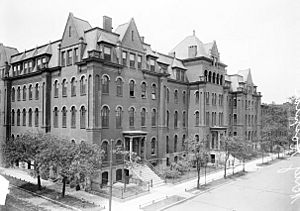
Later, Evans taught at Rush Medical College in Chicago, moving there in 1848. He created a plan for preventing the spread of cholera and spoke about it to the United States Congress. He also invented a special tool to help deliver babies more safely. He owned and edited a medical journal.
He helped start Lakeside Hospital and brought the Sisters of Mercy to work there. This hospital is now known as Mercy Hospital. He also founded the Illinois State Medical Society. In 1872, he patented a special bed for ships in several countries. This bed was designed to help people avoid seasickness.
Founding Educational Institutions
On June 4, 1850, John Evans was part of a group of Methodists who started Northwestern University. He was chosen as the first president of its Board of Trustees. He gave money and land to the university even after he moved to Colorado. Northwestern University opened in Evanston, Illinois (named after him) in November 1855.
In Denver, Governor Evans gave land across from his home. In March 1864, he received permission from the government to start the first college in the territory. This college was called the Colorado Seminary, and it later became the University of Denver. Evans led the university's board until he died in 1897. In 1890, he donated more land in southeast Denver for a new university campus. This area is now called University Park.
Business and Railroads
John Evans became very wealthy by investing in land, banks, and railroads in Chicago. He helped build the Fort Wayne and Chicago Railroad. By the mid-1850s, he was so successful that he stopped practicing medicine.
He also helped create the Denver Pacific Railroad. This railroad connected Denver to the Union Pacific Railroad's main line in Cheyenne, Wyoming. Evans was elected president of the Denver Pacific Railroad in 1868. The connection was finished in 1870. In 1875, the Denver, South Park and Pacific Railroad was started. This brought train service to Colorado's mining areas. In the 1880s, he built the Denver and New Orleans Railroad. These railroads helped Denver grow from a small frontier town to a city of over 100,000 people by the 1880s.
Political Career
From 1853 to 1855, Evans served as an alderman (a city council member) in Chicago. He focused on improving education, public health, and city development. His wealth gave him a lot of political influence. He was one of the founders of the Illinois Republican Party. He believed that slavery was wrong. He became a personal friend of Abraham Lincoln after helping him campaign in 1860.
On March 26, 1862, President Lincoln appointed John Evans as the second Governor of the Colorado Territory. Evans took his oath on April 11 in Washington, D.C., and arrived in Denver on May 16. As governor, he helped set up the legal system, schools, economy, and transportation in Colorado. He also wanted Colorado to become a state. However, in September 1864, most citizens voted against it. They worried about men having to join the army during the American Civil War and that the territory couldn't afford to run itself without federal help.
Evans was also in charge of Native American affairs for the territory. He did not fully understand how much the arrival of settlers affected Native Americans' lives and their access to important resources. Evans's plan was to make treaties that gave land to white settlers from Native American tribes.
He believed that building railroads from the east and through Colorado was vital for the territory's growth. He worked with survey teams to find the best routes. He also worked on enforcing treaties that assigned Native American tribes to reservations. Native American tribes like the Arapaho, Cheyenne, Kiowa, Ute people, and Sioux had lived and hunted in Colorado for a long time. As more settlers arrived, tensions grew. There was also concern that Native American people might join the Confederate army during the Civil War. Evans worked hard in Washington, D.C., to get railroads for Colorado. He was key in getting the Union Pacific Railroad to connect to Denver. He also helped plan a railroad line to San Francisco and another from Denver to Galveston, Texas.
The Sand Creek Massacre
People in Denver worried that Native American tribes were gathering to attack the city. Governor Evans had received approval from President Lincoln to shoot any member of a hostile tribe on sight. In August 1864, Evans issued a statement. It allowed "all citizens of Colorado... to go in pursuit of all hostile Indians [and] kill and destroy all enemies of the country." Because many men were away fighting in the Civil War, Denver was hard to defend. Evans ordered that "friendly" Native Americans should report to certain forts for their "safety and protection." Those who did not were considered "hostile" and should be "pursued and destroyed."
Chief Black Kettle, a Cheyenne leader, believed it was important for his people to make peace with the settlers. He met with President Lincoln and was proud to receive a large American flag in the fall of 1864. Only a few Native Americans, including Black Kettle, accepted Evans's offer of safety at the forts.
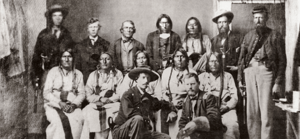
That year, Governor Evans appointed John Chivington as a Colonel in the Colorado Volunteers. Chivington and his men knew about Black Kettle's group of Cheyenne and Arapaho. Black Kettle's group had reported to Fort Lyon as ordered by Evans. But they left when there were no supplies for them there. Black Kettle and his group then camped along Sand Creek in the eastern part of the territory. This area was within Arapaho and Cheyenne land according to a treaty from 1861.
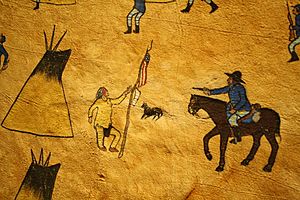
On November 29, 1864, Colonel Chivington ordered 700 cavalry soldiers to attack Black Kettle's peaceful camp. Most of the men from the camp were away hunting. The soldiers killed about 28 unarmed men and 105 women and children. Many more were wounded during the Sand Creek massacre. A few Cheyenne, including Black Kettle, managed to escape. Governor Evans praised Chivington and his men for their "bravery in subduing the savages."
Two U.S. Congressional committees and one military committee investigated the massacre in 1865. They found that the U.S. Government was responsible. Evans was accused of trying to hide the truth. He was forced to resign as Governor in 1865, and Chivington's political career was ruined.
Personal Life
John Evans married Hannah Canby in 1838. They lived in Attica, Indiana, where their sons Joseph (born 1839) and Davis (born 1841) were born. Evans was raised in the Quaker faith but became a Methodist. He also became a member of the Freemasons. His daughter Josephine was born in Attica, but his sons died there. Josephine was the only one of their four children to live past childhood. Hannah became ill with tuberculosis after the family moved to Chicago in 1848. She died on October 9, 1850. Hannah Canby Evans and their sons are buried in Attica.
On August 18, 1853, he married Margaret Patten Gray. She was the sister-in-law of a friend who also served on the board of Northwestern University. In 1855, he moved to a large house in Evanston, Illinois, the town named after him. In 1855, John and Margaret had a son, William Gray Evans. William later helped develop the Moffat Tunnel and the Denver Tramway Company. John Evans moved to Denver in 1862 and had a house there.
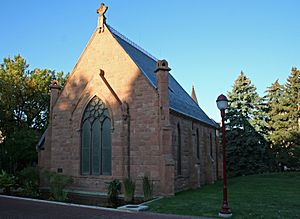
In 1871, their daughter Anne was born. Anne later played a big part in developing the Central City Opera, Civic Center Park, the Denver Public Library, and the Denver Art Museum.
John's daughter, Josephine, married Samuel Hitt Elbert. She died when she was young, and Evans built the Evans Memorial Chapel in her memory. In 1868, John Evans and Samuel Elbert bought land near Evergreen, Colorado. They used it as a summer home and ranch called Evans–Elbert Ranch.
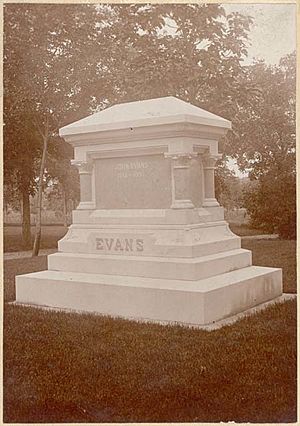
John Evans was not well in the last year of his life. His wife took over managing his property in November 1896. He died in Denver on July 2 or 3, 1897.
Legacy and Remembrance
John Evans's daughter, Josephine Evans Elbert, was married to Samuel Hitt Elbert. Samuel Elbert was the sixth Governor of Colorado Territory from 1873 to 1874. Mount Evans is named in John Evans's honor, and Mount Elbert is named after his son-in-law.
In World War II, the United States liberty ship SS John Evans was named in his honor.
In 1963, he was recognized and added to the Hall of Great Westerners at the National Cowboy & Western Heritage Museum.
In recent times, people have looked more closely at John Evans's actions and beliefs about Native Americans. The Colorado State Historian, David Halaas, has noted that Evans held views that were harmful towards Native American people. This new understanding helps us see the full picture of his historical impact.
See also
 In Spanish: John Evans (gobernador) para niños
In Spanish: John Evans (gobernador) para niños
Images for kids


